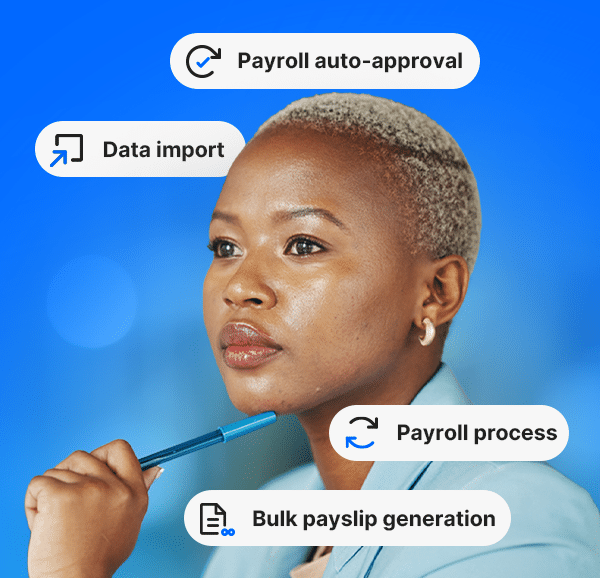In our recent webinar on the subject of CloudPay and Workday’s newer collaborative payroll features and enhancements, we received some fantastic questions. Many of these went deep into how our integration does and should work, so as the webinar hosts, we thought we’d provide some insightful answers.
To make it easier to digest, we’ve grouped the most relevant Q&As into the key themes that kept cropping up, and we’ve also anonymised all of the questions, not least because we hope their appeal will be fairly universal:
Additional Payroll Data
Q: If I understand Additional Payroll Data correctly, it displays CloudPay forms with payroll data directly in Workday?
“Correct! These are CloudPay fields embedded within Workday, with data actually stored within CloudPay. This means that the look and feel of these fields will be dependent on your global payroll provider.” – Sammy Molinaro
Q: “What type of auditing is there that will enable users to see a payroll that doesn’t feed through?
“For Additional Payroll Data, there are a number of error messages depending on the scenario. For Data Changes on Demand we will notify if a data pull fails. This is an area we need to work closely with customers on to understand how they would like to be notified.” – Adam Dennis
Q: Are the validation checks in Workday, or in CloudPay?
“For Additional Payroll Data, the validations are provided by CloudPay, but fully visible within Workday as these are our embedded fields which employees and admins are interacting with. Further validations beyond the point of entry are available in CloudPay. However we are looking to push more of those notifications to Workday to provide more data, sooner, in one place.” – Sammy Molinaro
Q: Which countries has Additional Payroll Data been rolled out for so far?
“We support 35 countries right now and will be rolling out more all the time! For a list, reach out to us.” – Adam Dennis
Data Changes on Demand
Q: In Workday, do you have visibility of what data was sent to CloudPay?
“For Data Changes on Demand, there is little auditing in Workday. So we are looking at how we can provide auditing tools for this. However we work very closely with Workday, so let us know what you want and we can speak to them about it.” – Adam Dennis
Q: Is data validation done when an employee enters data themselves as well, or just when an admin submits data?
“Both! Employees or admins will be able to enter data that has been correctly formatted.” – Sammy Molinaro
Q: If we’re currently set up on PECI with CloudPay in a country, and want to move to Global Payroll Connect/Payroll HUB – what is the extent of resources required?
“Additional Payroll Data and Global Payroll Hub are standalone features and can be used with PECI. Data Changes on Demand itself is an alternative to PECI that will require greater implementation times and resources.” – Adam Dennis
Data Validations
Q: How will the Data Validations work when being pushed into Workday?
“Inbound Notifications allows us to send any notification to Workday. So, our first use case is validations. These could be Data-in/Pre/Post validations or any other useful ways we can communicate direct to Workday. If you have use cases, I want to hear them!”
Q: Is data validation done when an employee enters data themselves as well, or just when an admin submits data?
“We will continue to validate how we do now and Data on Demand will remain. It just gives us additional options for exposing this back to Workday, so that they can streamline processes.” – Adam Dennis
Q: If we’re currently set up on PECI with CloudPay in a country, and want to move to Global Payroll Connect/Payroll HUB – what is the extent of resources required?
“They can be sent to anyone you wish: Data owner, Data submitter, HR Team, Payroll team. You can decide.” – Adam Dennis
User experience
Q: How does it work if an employee needs to sign tax forms? Can a PDF be populated and routed to the employee for signature during onboarding?
“This is an enhancement coming from Workday very soon!” – Adam Dennis
Q: Workday will be synced with CloudPay. So what will be the data entry point for information like bank details when new starters are onboarding? Workday or CloudPay?
“Workday should be the source for employee bank details. CloudPay are able to consume this information as part of the existing PECI integration, and this will also be included as part of Data Changes on Demand.” – Sammy Molinaro
Q: Why not just have the global payroll processing information within CloudPay? What is the benefit of having this in Workday considering the cost and time to implement this?
“This information is already available in Cloudpay. To implement the Global Payroll Hub takes very little time. I have done this myself and it took less than 30 mins to configure. The value in exposing this information in Workday is that you may have multiple vendors. Plus, this feature will evolve over time to do even more.” – Adam Dennis
If you have any questions of your own about the latest features of CloudPay’s integration with Workday, how these work, and what’s coming up in the future – don’t hesitate to get in touch and ask our high-performance payroll people.
You can also read more information on CloudPay and Workday’s strategic partnership, or watch our webinar on unlocking CloudPay and Workday’s product features.



